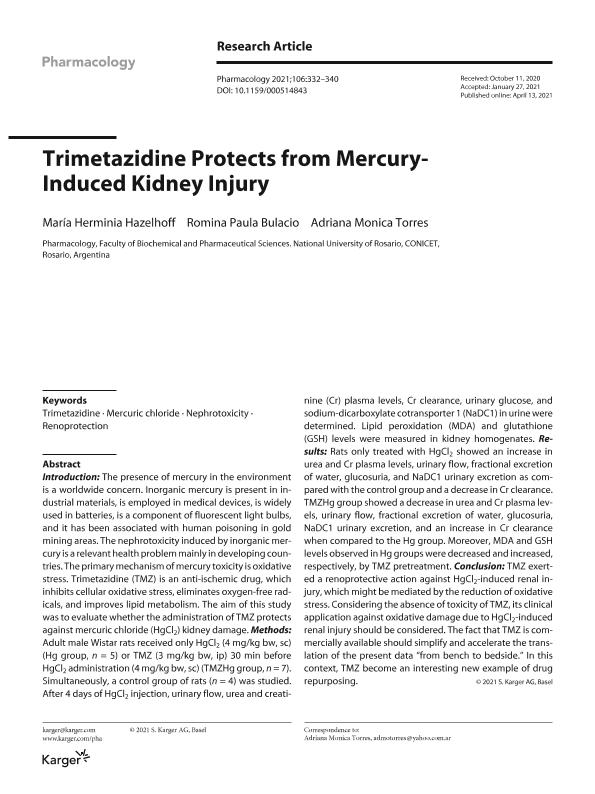Artículo
Trimetazidine Protects from Mercury-Induced Kidney Injury
Fecha de publicación:
13/04/2021
Editorial:
Karger
Revista:
Pharmacology
ISSN:
0031-7012
e-ISSN:
1423-0313
Idioma:
Inglés
Tipo de recurso:
Artículo publicado
Clasificación temática:
Resumen
Introduction: The presence of mercury in the environment is a worldwide concern. Inorganic mercury is present in industrial materials, is employed in medical devices, is widely used in batteries, is a component of fluorescent light bulbs, and it has been associated with human poisoning in gold mining areas. The nephrotoxicity induced by inorganic mercury is a relevant health problem mainly in developing countries. The primary mechanism of mercury toxicity is oxidative stress. Trimetazidine (TMZ) is an anti-ischemic drug, which inhibits cellular oxidative stress, eliminates oxygen-free radicals, and improves lipid metabolism. The aim of this study was to evaluate whether the administration of TMZ protects against mercuric chloride (HgCl2) kidney damage. Methods: Adult male Wistar rats received only HgCl2 (4 mg/kg bw, sc) (Hg group, n = 5) or TMZ (3 mg/kg bw, ip) 30 min before HgCl2 administration (4 mg/kg bw, sc) (TMZHg group, n = 7). Simultaneously, a control group of rats (n = 4) was studied. After 4 days of HgCl2 injection, urinary flow, urea and creatinine (Cr) plasma levels, Cr clearance, urinary glucose, and sodium-dicarboxylate cotransporter 1 (NaDC1) in urine were determined. Lipid peroxidation (MDA) and glutathione (GSH) levels were measured in kidney homogenates. Results: Rats only treated with HgCl2 showed an increase in urea and Cr plasma levels, urinary flow, fractional excretion of water, glucosuria, and NaDC1 urinary excretion as compared with the control group and a decrease in Cr clearance. TMZHg group showed a decrease in urea and Cr plasma levels, urinary flow, fractional excretion of water, glucosuria, NaDC1 urinary excretion, and an increase in Cr clearance when compared to the Hg group. Moreover, MDA and GSH levels observed in Hg groups were decreased and increased, respectively, by TMZ pretreatment. Conclusion: TMZ exerted a renoprotective action against HgCl2-induced renal injury, which might be mediated by the reduction of oxidative stress. Considering the absence of toxicity of TMZ, its clinical application against oxidative damage due to HgCl2-induced renal injury should be considered. The fact that TMZ is commercially available should simplify and accelerate the translation of the present data “from bench to bedside.” In this context, TMZ become an interesting new example of drug repurposing.
Palabras clave:
TRIMETAZIDINE
,
MERCURIC CHLORIDE
,
NEPHROTOXICITY
,
RENOPROTECTION
Archivos asociados
Licencia
Identificadores
Colecciones
Articulos(CCT - ROSARIO)
Articulos de CTRO.CIENTIFICO TECNOL.CONICET - ROSARIO
Articulos de CTRO.CIENTIFICO TECNOL.CONICET - ROSARIO
Citación
Hazelhoff, Maria Herminia; Bulacio, Romina Paula; Torres, Adriana Mónica; Trimetazidine Protects from Mercury-Induced Kidney Injury; Karger; Pharmacology; 106; 5-6; 13-4-2021; 1-9
Compartir
Altmétricas




